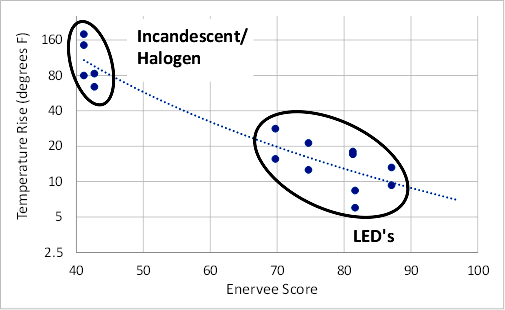When most people think of trying to stay cool on a hot summer day, the last thing they think of is energy efficiency. You are hot, you want to be cool and you are going to TURN UP that air conditioner. But one thing that most people don’t realize, is that more than half of the energy that their air conditioner is expending may be cooling the appliances and equipment in their house rather than them….if they haven’t made their light bulbs, TVs, and appliances energy efficient.
Our bodies generate the same heat as a 100 watt light bulb. The average metabolic rate of 2,000 calories per day corresponds to an average continuous energy expenditure of 97 watts. A large refrigerator uses approximately the same amount of energy, which means as the refrigerator is cooling the food inside, it is generating about 100 watts of heat that is put out into your kitchen’s environment. So when your air conditioning is cooling your house for you and your refrigerator, it is essentially “cooling for two.”
Or perhaps you have a kitchen or living room that has half a dozen 65 watt ceiling lights, which collectively generate 390 watts. Cooling a house with you and your kitchen lights is like cooling a kitchen full of five people. To illustrate this concept, we at Enervee performed a little experiment in our workspace kitchenette that has nine 65-watt equivalent downlights in its ceiling. We wanted to get a measurement of how much heat the different lights were generating as they were lighting up the kitchen. We conducted our experiment in three simple steps:
Step #1: We went to our local hardware store and purchased seven different types of 65-watt equivalent light bulbs each with different energy efficiencies. We also purchased an infrared digital thermometer which costs approximately $30.
Step #2: We took the light bulbs back to the office and randomly distributed them in our kitchen light sockets and labeled the make, wattage, and efficacy (lumens/watts) of each bulb
Step #3: We turned the lights on, and measured their temperature with the infrared digital thermometer to see how much the different light bulbs are heating their surroundings.

The graph above, illustrates the result: The least efficient light bulbs have a temperature rise as high as 180 degrees Fahrenheit above their surroundings. The highest temperature that we read surpassed 250 degrees Fahrenheit (75 degree room temperature + a 180 degree temperature rise). While the efficient LED light bulbs had a temperature rise of only 5 to 30 degrees Fahrenheit.
The temperature rise we observed was directly correlated with the wattage (and efficiency) of the bulb. Because all of the bulbs had roughly the same light output, the higher efficiency bulbs had lower wattage and correspondingly lower temperatures.
The same principal holds for other energy using products: the more inefficient a product, the more electricity is wasted and turned into heat. The heat generated by the inefficiency of the device turns your TV, refrigerator, or computer monitor into a small heater. Having dozens of small heaters running in your house on a hot day, makes your air conditioner work harder, forcing your cooling system to use even more electricity and making it harder to keep your home cool on a hot day.
This means that if you want to stay cool on a hot day, you should get efficient appliances and light bulbs so that your air conditioner can focus its efforts on cooling you, and not your electronics.
What this means of course is that the Enervee Score is not just cool because it helps you save money and helps you help the planet; The Enervee Score’s also cool because it quite literally helps you keep your house cooler on those hot summer days.

